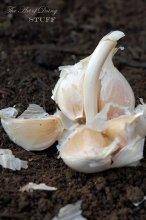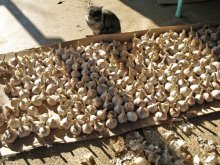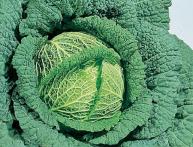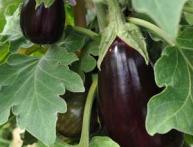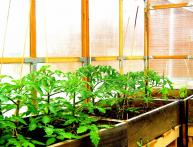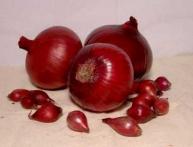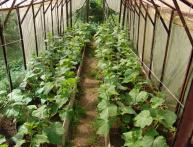Growing winter garlic in three approaches
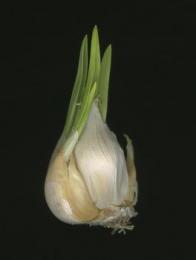
Garlic – the most popular vegetable crop among different nations. There is spring and winter garlic. I will turn my attention to growing winter garlic.
Content:
Renewing garlic with bulbs
The most common method of growing winter garlic – growing from cloves. But it happens that with this method it begins to get smaller every year; in this case, growing winter garlic should take place in three approaches.
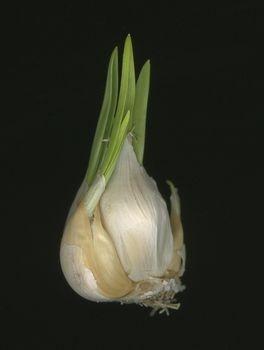
- 1 year - we take four-prong heads, select the largest ones and plant them. From the grown heads and seeds from the bulbs on the arrows, we again select the largest ones for next year.
- Year 2 - we plant seeds from the first year bulbs in the garden bed, we get round heads (single teeth). The arrows do not appear.
- Year 3 – we plant single-toothed trees. They will give full heads with arrows.
Winter garlic is usually planted in late September - early October. It is better to plant such garlic in high beds in 2, 3 or 4 rows, 35-40 cm from each other.
In the third year we have single teeth and seeds from bulbs. You can plant them in 2-3 beds at once. Large cloves are for seeds.
Winter garlic should be planted at a depth of five to seven centimeters (cloves and single cloves), three to five centimeters for seeds from bulbs; use longitudinal grooves.After planting the garlic, fill the furrows with compost humus at the same level as the bed, and sprinkle earth on top.
When planting, it’s good to pour a tablespoon of sand into each hole, then put a clove, then pour a tablespoon of sand again. Good micro-drainage is created around the heads with the help of added sand, so your future harvest will be protected from waterlogging.
At the beginning of spring (late April), garlic should be fed with urea. The second feeding is a week after the first. The third is in June.
It is necessary to water once a week, provided that there is no rain.
When the fifth leaf appears, the garlic shoots out. Then you should dig out the soil to about half the bulb. When the arrows unfold to the end (end of July), they need to be cut off. At the same time, the heads of garlic are dug up and placed under cover (canopy) until the leaves dry completely. Then everything is cut off, leaving only the head, ready for use.
Soil and lighting
Unlike onions, garlic is more demanding culture in relation to the soil. It needs cultivated, loose soils with a significant organic content. Garlic is still very sensitive to increased soil acidity.
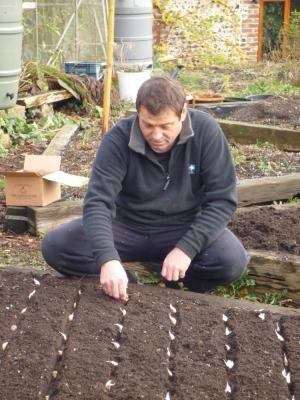
In addition, it is more frost-resistant and even drought-resistant compared to onions, but it needs more light and moisture.
Predecessors and successors
Early harvested crops are good predecessors for garlic. These include cucumber, early cabbage, carrots, greens. To avoid damage by pests and diseases, it is not recommended to plant garlic after onions and garlic. Many people plant garlic among strawberry plantations.But this is unlikely to help in the fight against nematodes; most likely, on the contrary, these unpleasant pests will appear in the bulbs.
To prevent the soil from eroding after harvesting garlic, its place can be planted with spinach, lettuce, radishes. It is also good to do such plantings so that the free space is not colonized by weeds. If there are already enough such crops in the garden, then sow the garden bed with white mustard; it perfectly restores the soil and protects it from weathering.
About garlic arrows
There are recommendations for twisting and tying garlic tops to weaken the formation of arrows. It is better not to do this, as foliage growth is weakened, photosynthesis is reduced, and, consequently, the nutrition of the garlic heads is reduced. In addition, various infections can penetrate into damaged leaf tissues, leading to diseases. Therefore, when flower arrows appear, they should be broken off.
To force the bulbs, it is enough to leave a couple of flower stalks, but then they need to be marked with some kind of peg or tied with a tag. When the cap on the arrow opens and bursts, you need to remove the plant from the bed along with the head, shake off the soil and hang it upside down to dry. The bulbs are removed after drying. Bulbs needed to improve the health of garlic and save material for planting.
Storage
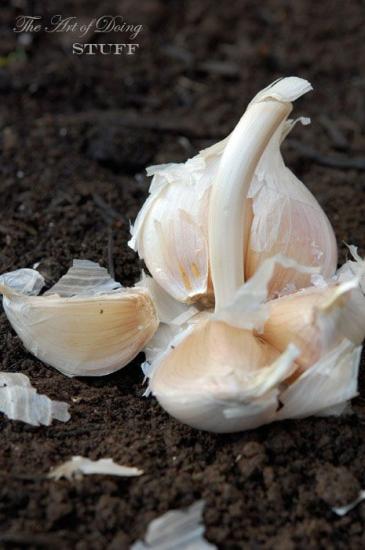
You should not store garlic separated into slices and sprinkled with salt. Salt actively absorbs moisture, and the garlic quickly wrinkles. You can put the dried garlic in three-liter jars, tying the neck with a cloth. There is no need to store garlic in refrigerators; it spoils much faster.
If at the time of cleaning you find any signs of rot or just mold, then it is better to clean the heads of excess scales, and immediately cut off the tops and roots. Then immerse whole heads of garlic in the Fitosporin solution for about 0.5 hours. Proceed to dry the garlic in the attic only after disinfection.
Remember that properly grown garlic will not only add a special taste to your dishes, but will also saturate your body with essential vitamins.


